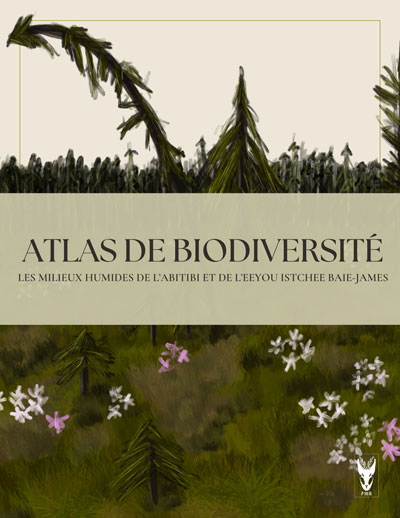
Daniel Fortin
Membre régulier
Écologie animale/Conservation
Université Laval
Faculté des sciences et de génie
Département de biologie
Pavillon Alexandre-Vachon, local 3039
1045 avenue de la Médecine
Québec(Québec) Canada, G1V 0A6
(418) 656-2131 Poste 405971
Biographie |
Thèmes de recherche |
Équipe
Distinctions reçues |
Publications
FORMATION
- Postdoctorat en biologie, 2003 (University of Alberta)
- Ph.D. en zoologie, 2001 (University of Guelph)
- M.Sc. en écophysiologie, 1996 (Université Laval)
- B.Sc. en écologie, 1992 (Université de Sherbrooke)
BIOGRAPHIE
- Professeur titulaire au Département de biologie de l'Université Laval
 .
.
- Co-titulaire, puis titulaire de la Chaire de recherche industrielle CRSNG-Université Laval en sylviculture et faune (2009-2015).
- Chercheur invité :
THÈMES DE RECHERCHE
Mes recherches visent principalement à comprendre les mécanismes comportementaux causant la répartition des populations animales dans des environnements hétérogènes. Cet objectif m'amène à aborder plusieurs thèmes, tels que l'utilisation et la sélection des ressources, les interactions trophiques et la réponse comportementale aux modifications anthropiques du paysage. Mon approche aux questions écologiques combine des études théoriques et des travaux de terrain. Somme toute, mes recherches ont pour but ultime d'aider à l'aménagement de la faune et à préserver la biodiversité environnementale en augmentant la compréhension de la dynamique spatio-temporelle des systèmes écologiques.
Mon programme de recherche comporte présentement quatre axes principaux:
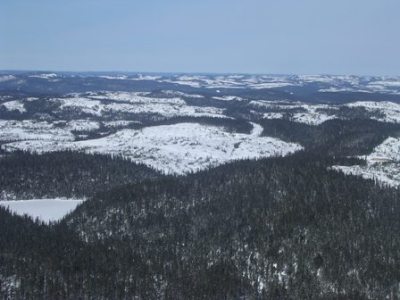
1. Sylviculture et faune de la forêt boréale
Ces travaux sont effectués dans le cadre de la Chaire de recherche industrielle CRSNG–Université Laval en sylviculture et faune. Le programme de recherche vise à acquérir les connaissances et de développer l’expertise requise pour élaborer des stratégies sylvicoles écosystémiques adaptées à la forêt boréale de structure irrégulière, de façon à respecter les critères reconnus d’aménagement durable des forêts, dont la conservation de la biodiversité. Des études sont entreprises sur un grand nombre d’animaux, allant des invertébrés au caribou forestier.
Principaux collaborateurs: David Pothier (U. Laval), Julien Mainguy(MDDEFP), Christian Hébert (Service canadien des forêts) et Jean-Claude Ruel (U. Laval)
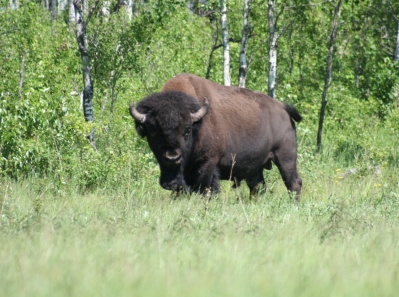
2. Bison du parc national de Prince Albert
Ces travaux visent à mieux connaître l'écologie du bison des plaines pour faire face au défi important qui consiste à conserver cette population, tout en minimisant l'impact des bisons sur les terres privées adjacentes au parc. Le but de ces recherches est aussi de comprendre l'interaction entre les bisons, d'autres espèces animales et les communautés végétales se retrouvant également dans le parc. Ces objectifs sont abordés en effectuant des études théoriques et empiriques sur le comportement d'approvisionnement, sur la sélection de la nourriture et des habitats ainsi que sur les patrons de déplacement des bisons.
Principal collaborateur: Seth Cherry (Parcs Canada)
Lien vers Parc national du Canada de Prince Albert ![]()
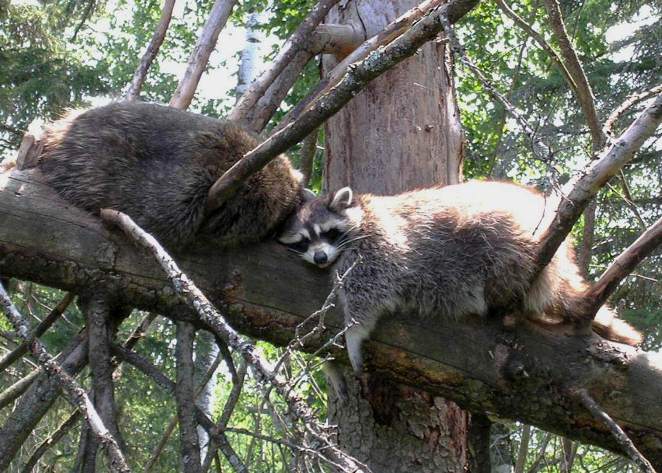
3. Déterminants écologiques du potentiel de propagation de la rage dans les populations de ratons laveurs et de moufettes rayées au Québec
Ce projet vise à évaluer le potentiel de propagation de la rage du raton laveur au Québec en utilisant une approche multidisciplinaire qui intègre l'écologie spatiale, la génétique du paysage, l'écologie comportementale et la dynamique des populations. La recherche inclut l’étude de la sélection de l’habitat et des déplacements des ratons laveurs et des moufettes rayées dans des paysages agro-forestiers, l’identification des caractéristiques du paysage influençant la structure et le flux génétique chez ces deux vecteurs de la rage, de même que la description de la structure sociale et la démographie des populations de ratons laveurs. Sur la base de cette information, un modèle épidémiologique spatial sera développé afin de prédire le potentiel de propagation de la rage. Nos résultats devraient permettre le développement de meilleures méthodes de gestion de la maladie chez les animaux et une réduction du risque d'exposition des humains aux animaux infectés.
Principaux collaborateurs: Fanie Pelletier (U. de Sherbrooke), Dany Garant (U. de Sherbrooke) et Ariane Massé (MDDEFP)
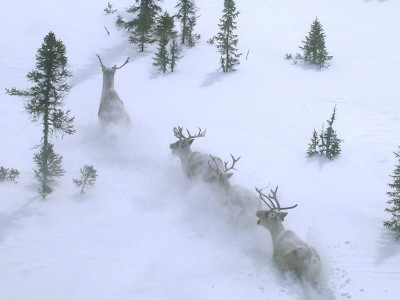
4. Évaluation panquébécoise des facteurs déterminant la dynamique des populations du caribou forestier
Le projet vise à acquérir une compréhension fine des attributs de l’habitat influençant la dynamique des populations du caribou forestier, de façon à pouvoir identifier des niveaux de perturbation qui ne compromettraient pas le rétablissement de l’écotype à travers la forêt boréale québécoise. Plus précisément, ce projet permettra: 1) D’établir le lien fonctionnel entre la fidélité au site, la mortalité juvénile et le recrutement des populations du caribou forestier; 2) d’évaluer les conséquences de la sélection de peuplements d’âge et d’origine (feu ou coupe) différents sur la survie du caribou, en fonction du cycle régional des feux; et 3) d’établir les variations régionales du niveau de perturbation maximal permettant le maintien des populations du caribou à partir d’une compréhension fine des relations habitat-biodémographie du caribou forestier.
Principaux collaborateurs: Martin-Hugues St-Laurent (UQAR), Pierre Drapeau (UQÀM), Julien Mainguy (MDDEFP), Ariane Massé (MDDEFP), Sonia Légaré (MRN), Claude Dussault (MRN) et Sandra Heppell (MRN)
ÉQUIPE
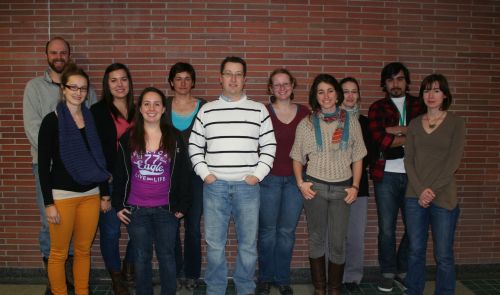
De gauche à droite: Jerod Merkle, Chrystel Losier, Caroline Gagné, Julie Martineau, Angélique Dupuch, Daniel Fortin, Hélène Le Borgne, Orphé Bichet, Olivia Tardy, Nicolás Caruso, Marie Sigaud
DISTINCTIONS REÇUES
- 2014-2015 - Professeur étoile, département de biologie, Faculté des sciences et de génie, Université Laval
- 2010-2011 - Professeur étoile, département de biologie, Faculté des sciences et de génie, Université Laval
- 2007-2008 - Professeur étoile, département de biologie, Faculté des sciences et de génie, Université Laval
- 2006-2007 - Professeur étoile, département de biologie, Faculté des sciences et de génie, Université Laval
- 2005-2006 - Professeur étoile, département de biologie, Faculté des sciences et de génie, Université Laval
- 2004-2005 - Professeur étoile, département de biologie, Faculté des sciences et de génie, Université Laval
Vous pouvez télécharger toutes mes références bibliographiques en format BibTeX, BibTeX-CSV, FRQNT ou EndNote
PUBLICATIONS
Livres
Aucun
Chapitres de livre
- Tyler, N.J.C., Forchhammer, M.C., Fortin, D., Gunn, A., Leblond, M., Panchenko, D. (2025) Reindeer/Caribou Rangifer tarandus (Linnaeus, 1758). In Deer of the world: Ecology, conservation and management. (Melletti, M. and Focardi, S., Eds.) Cham, Springer Nature Switzerland, pages 681-707
- Fortin, D., Hebert, C., Legare, J.-P., Courbin, N., Swiston, K., Hodson, J., LeBlanc, M.-L., Dussault, C., Pothier, D., Ruel, J.-C. et al. (2011) Partial harvesting in old-growth boreal forests and the preservation of animal diversity from ants to woodland caribou. In Woodlands: Ecology, Management and Conservation. (Wallace, E.B., Eds.) New York, USA, Nova Science Publishers, pages 115-136
- Fortin, D., Dancose, K., Courbin, N., Harvey, L., Babin, J.-S., Courant, S., Wilmshurst, J.F., Frandsen, D. (2010) The use of ecological theory to guide bison management. In European bison conservation in Białowieża Forest. Threats and prospects of the population development. (Kowalczyk, R., Ławreszuk, D. and Wojcik, J.M., Eds.) Mammal Research Institute, Polish Academy of Sciences, Białowieża, Poland., pages 201-210
Livres, numéros spéciaux et actes de colloques publiés à titre d'éditeur
Aucun
Articles révisés par un comité de lecture
- Benson, J.F., Keiter, D.A., Mahoney, P.J., Allen, B.L., Allen, L., Alvares, F., Anderson, M.L., Barber-Meyer, S.M., Barocas, A., Beasley, J.C. et al. (2025) Intrinsic and environmental drivers of pairwise cohesion in wild Canis social groups. Ecology, 106(1):e4492
- Atmeh, K., Bonenfant, C., Gaillard, J.-M., Garel, M., Hewison, A.J.M., Marchand, P., Morellet, N., Anderwald, P., Buuveibaatar, B., Beck, J.L. et al. (2025) Neonatal antipredator tactics shape female movement patterns in large herbivores. Nature Ecology & Evolution, 9(1):142-152
- Serieys, L.E., Hickling, C.J., Fortin, D., Rogan, M.S., Kachel, S., Elbroch, L.M., Sager-Fradkin, K., Stratton, A., Kupar, C., Moehrenschlager, A. et al. (2025) Bobcats select young forests and avoid clear-cut and mature forests in a timber-logged landscape. Forest Ecology and Management, 588:122764
- Labadie, G., Bouderbala, I., Boulanger, Y., Beland, J.-M., Hebert, C., Allard, A., Hebblewhite, M., Fortin, D. (2024) The umbrella value of caribou management strategies for biodiversity conservation in boreal forests under global change. Science of the Total Environment, 907:168087
- Fortin, D., Brooke, C.F., Fritz, H., Venter, J.A. (2024) The temporal scale of energy maximization explains allometric variations in movement decisions of large herbivores. Ecosphere, 15(12):e70101
- Boulanger, Y., Puigdevall, J.P., Belisle, A.C., Bergeron, Y., Brice, M.-H., Cyr, D., De Grandpre, L., Fortin, D., Gauthier, S., Grondin, P. et al. (2023) A regional integrated assessment of the impacts of climate change and of the potential adaptation avenues for Quebec's forests. Canadian Journal of Forest Research, 53(8):556-578
- Labadie, G., Hardy, C., Boulanger, Y., Vanlandeghem, V., Hebblewhite, M., Fortin, D. (2023) Global change risks a threatened species due to alteration of predator–prey dynamics. Ecosphere, 14(3):e4485
- Bouderbala, I., Labadie, G., Beland, J.-M., Boulanger, Y., Hebert, C., Desrosiers, P., Allard, A., Fortin, D. (2023) Effects of global change on bird and beetle populations in boreal forest landscape: An assemblage dissimilarity analysis. Diversity and Distributions, 29(6):757-773
- Bouderbala, I., Labadie, G., Beland, J.-M., Tremblay, J.A., Boulanger, Y., Hebert, C., Desrosiers, P., Allard, A., Fortin, D. (2023) Long-term effect of forest harvesting on boreal species assemblages under climate change. PLOS Climate, 2(3):e0000179
- Fortin, D., Cimon-Morin, J. (2023) Public opinion on the conflict between the conservation of at-risk species and the extraction of natural resources: The case of caribou in boreal forest. Science of The Total Environment, 897:165433
- Mazaleyrat, A., Lorenzetti, F., Aubin, I.e, Venier, L.A., Hébert, C., Fortin, D., Dupuch, A. (2022) Towards a better understanding of the effect of anthropogenic habitat disturbance on the invasion success of non-native species: slugs in eastern Canadian forests. Biological Invasions, 24(5):1267 – 1281
- Terrigeol, A., Ewane Ebouele, S., Darveau, M., Hebert, C., Rivest, L.-P., Fortin, D. (2022) On the efficiency of indicator species for broad-scale monitoring of bird diversity across climate conditions. Ecological Indicators, 137:108773
- Prima, M.-C., Duchesne, T., Merkle, J.A., Chamaille-Jammes, S., Fortin, D. (2022) Multi-mode movement decisions across widely ranging behavioral processes. PLOS ONE, 17(8):e0272538
- Fortin, D., Berube, A.-J., Boudreau, S., Shrader, A., Ward, D. (2022) Density-dependent habitat selection varies between male and female African elephants. Biological Conservation, 276:109794
- Vanlandeghem, V., Drapeau, P., Prima, M.-C., St-Laurent, M.-H., Fortin, D. (2021) Management-mediated predation rate in the caribou–moose–wolf system: spatial configuration of logging activities matters. Ecosphere, 12(6)
- Neufeld, B.T., Superbie, C., Greuel, R.J., Perry, T., Tomchuk, P.A., Fortin, D., McLoughlin, P.D. (2021) Disturbance-Mediated Apparent Competition Decouples in a Northern Boreal Caribou Range. The Journal of Wildlife Management, 85(2):254-270
- Drever, R., Hutchison, C., Drever, M.C., Fortin, D., Johnson, C.A., Wiersma, Y.F. (2021) Corrigendum to ‘Conservation through co-occurrence: Woodland caribou as a focal species for boreal biodiversity [Biol. Conserv. 232 (2019) 238–252]’ (Biological Conservation (2019) 232 (238–252), (S0006320718317269), (10.1016/j.biocon.2019.01.026)). Biological Conservation, 260
- Labadie, G., McLoughlin, P.D., Hebblewhite, M., Fortin, D. (2021) Insect-mediated apparent competition between mammals in a boreal food web. Proceedings of the National Academy of Sciences of the United States of America, 118(30)
- Brooke, C.F., Fortin, D., Kraaij, T., Fritz, H., Kalule-Sabiti, M.-J., Venter, J.A. (2020) Poaching impedes the selection of optimal post-fire forage in three large grazing herbivores. Biological Conservation, 241:108393
- Fortin, D., McLoughlin, P.D., Hebblewhite, M. (2020) When the protection of a threatened species depends on the economy of a foreign nation. PLOS ONE, 15(3)
- Simon, R.N., Fortin, D. (2020) Crop raiders in an ecological trap: optimal foraging individual-based modeling quantifies the effect of alternate crops. Ecological Applications, 30(5)
- Le Borgne, H.L., Fortin, D. (2020) Functional responses in habitat use explain changes in animal–habitat interactions during forest succession. Canadian Journal of Forest Research, 50(6):549-556
- Fortin, D., Brooke, C.F., Lamirande, P., Fritz, H., McLoughlin, P.D., Pays, O. (2020) Quantitative Spatial Ecology to Promote Human-Wildlife Coexistence: A Tool for Integrated Landscape Management. Frontiers in Sustainable Food Systems, 4:230
- Shave, J.R., Cherry, S.G., Derocher, A.E., Fortin, D. (2020) Seasonal and inter-annual variation in diet for gray wolves Canis lupus in Prince Albert National Park, Saskatchewan. Wildlife Biology, 2020(3)
- Sigaud, M., Mason, T.H.E., Barnier, F., Cherry, S.G., Fortin, D. (2020) Emerging conflict between conservation programmes: when a threatened vertebrate facilitates the dispersal of exotic species in a rare plant community. Animal Conservation, 23(6):660-669
- Lafontaine, A., Drapeau, P., Fortin, D., Gauthier, S., Boulanger, Y., St-Laurent, M.-H. (2019) Exposure to historical burn rates shapes the response of boreal caribou to timber harvesting. Ecosphere, 10(5)
- Prima, M.-C., Duchesne, T., Fortin, A., Rivest, L.-P., Drapeau, P., St-Laurent, M.-H., Fortin, D. (2019) A landscape experiment of spatial network robustness and space-use reorganization following habitat fragmentation. Functional Ecology, 33(9):1663-1673
- Patin, R., Fortin, D., Sueur, C., Chamaille-Jammes, S. (2019) Space Use and Leadership Modify Dilution Effects on Optimal Vigilance under Food-Safety Trade-Offs. American Naturalist, 193(1):E15-E28
- Drever, R.D., Hutchison, C., Drever, M.C., Fortin, D., Johnson, C.A., Wiersma, Y.F. (2019) Conservation through co-occurrence: Woodland caribou as a focal species for boreal biodiversity. Biological Conservation, 232:238 - 252
- Simon, R.N., Fortin, D. (2019) Linking habitat use to mortality and population viability to disarm an ecological trap. Biological Conservation, 236:366-374
- Speed, J.D.M., Skjelbred, I.A., Barrio, I.C., Martin, M.D., Berteaux, D., Bueno, C.G., Christie, K.S., Forbes, B.C., Forbey, J., Fortin, D. et al. (2019) Trophic interactions and abiotic factors drive functional and phylogenetic structure of vertebrate herbivore communities across the Arctic tundra biome. Ecography, 42(6):1152-1163
- Simon, R.N., Cherry, S.G., Fortin, D. (2019) Complex tactics in a dynamic large herbivore–carnivore spatiotemporal game. Oikos, 128(9):1318-1328
- Cherry, S.G., Merkle, J.A., Sigaud, M., Fortin, D., Wilson, G.A. (2019) Managing Genetic Diversity and Extinction Risk for a Rare Plains Bison (Bison bison bison) Population. Environmental Management, 64(5):553-563
- Muhly, T.B., Johnson, C.A., Hebblewhite, M., Neilson, E.W., Fortin, D., Fryxell, J.M., Latham, A.D.M., Latham, M.C., McLoughlin, P.D., Merrill, E. et al. (2019) Functional response of wolves to human development across boreal North America. Ecology and Evolution, 9(18):10801-10815
- Le Borgne, H., Hébert, C., Dupuch, A., Bichet, O., Pinaud, D., Fortin, D. (2018) Temporal dynamics in animal community assembly during post-logging succession in boreal forest. PLOS ONE, 13(9)
- Tardy, O., Masse, A., Pelletier, F., Fortin, D. (2018) Interplay between contact risk, conspecific density, and landscape connectivity: An individual-based modeling framework. Ecological Modelling, 373:25-38
- Prima, M.-C., Duchesne, T., Fortin, A., Rivest, L.-P., Fortin, D. (2018) Combining network theory and reaction–advection–diffusion modelling for predicting animal distribution in dynamic environments. Methods in Ecology and Evolution, 9(5):1221-1231
- Le Borgne, H., Dupuch, A., Fortin, D. (2018) Ecological processes determining the distribution dynamics of vole populations during forest succession. Oecologia, 188(3):721-732
- Lafontaine, A., Drapeau, P., Fortin, D., St-Laurent, M.-H. (2017) Many places called home: the adaptive value of seasonal adjustments in range fidelity. Journal of Animal Ecology, 86(3):624-633
- Cyr, G., Raulier, F., Fortin, D., Pothier, D. (2017) Using operating area size and adjacency constraints to mitigate the effects of harvesting activities on boreal caribou habitat. Landscape Ecology, 32(2):377-395
- Nicosia, A., Duchesne, T., Rivest, L.P., Fortin, D. (2017) A general hidden state random walk model for animal movement. Computational Statistics & Data Analysis, 105:76 - 95
- Sigaud, M., Merkle, J.A., Cherry, S.G., Fryxell, J.M., Berdahl, A., Fortin, D. (2017) Collective decision-making promotes fitness loss in a fusion-fission society. Ecology Letters, 20(1):33-40
- Prima, M.-C., Duchesne, T., Fortin, D. (2017) Robust inference from conditional logistic regression applied to movement and habitat selection analysis. PLOS ONE, 12(1)
- Merkle, J. A., Potts, J. R., Fortin, D. (2017) Energy benefits and emergent space use patterns of an empirically parameterized model of memory-based patch selection. Oikos, 126(2)
- Zhao, Q., Mason, T. H. E., Azeria, E. T., Le Blanc M.-L., Lemaitre, J., Barnier, F., Bichet, O., Fortin, D. (2017) Robust predictive performance of indicator species despite different co-occurrence patterns of birds in natural and managed boreal forests. Forest Ecology and Management, 397:108 - 116
- Mason, T. H. E., Fortin, D. (2017) Functional responses in animal movement explain spatial heterogeneity in animal-habitat relationships. Journal of Animal Ecology, 86(4):960-971
- Fortin, D., Barnier, F., Drapeau, P., Duchesne, T., Dussault, C., Heppell, S., Prima, M.-C., St-Laurent, M.-H., Szor, G. (2017) Forest productivity mitigates human disturbance effects on late-seral prey exposed to apparent competitors and predators. Scientific Reports, 7(1)
- Nicosia, A., Duchesne, T., Rivest, L.-P., Fortin, D. (2017) A multi-state conditional logistic regression model for the analysis of animal movement. The Annals of Applied Statistics, 11(3):1537-1560
- Bichet, O., Dupuch, A., Hebert, C., Le Borgne, H., Fortin, D. (2016) Maintaining animal assemblages through single-species management: The case of threatened caribou in boreal forest. Ecological Applications, 26(2):612-623
- Martineau, J., Pothier, D., Fortin, D. (2016) Processes driving short-term temporal dynamics of small mammal distribution in human-disturbed environments. Oecologia, 181(3):831-840
- Rivest, L.-P., Duchesne, T., Nicosia, A., Fortin, D. (2016) A general angular regression model for the analysis of data on animal movement in ecology. Journal of the Royal Statistical Society: Series C-Applied Statistics, 65:445-463
- Caruso, N., Lucherini, M., Fortin, D., Casanave, E.B. (2016) Species-Specific Responses of Carnivores to Human-Induced Landscape Changes in Central Argentina. PLOS ONE, 11(3)
- Gagne, C., Mainguy, J., Fortin, D. (2016) The impact of forest harvesting on caribou-moose-wolf interactions decreases along a latitudinal gradient. Biological Conservation, 197:215-222
- Lardy, S., Fortin, D., Pays, O. (2016) Increased exploration capacity promotes group fission in gregarious foraging herbivores. PLOS ONE, 11(12)
- Losier, C.L., Couturier, S., St-Laurent, M.-H., Drapeau, P., Dussault, C., Rudolph, T.D., Brodeur, V., Merkle, J.A., Fortin, D. (2015) Adjustments in habitat selection to changing availability induce fitness costs for a threatened ungulate. Journal of Applied Ecology, 52(2):496-504
- Fortin, D., Merkle, J.A., Sigaud, M., Cherry, S.G., Plante, S., Drolet, A., Labrecque, M. (2015) Temporal dynamics in the foraging decisions of large herbivores. Animal Production Science, 55(3):376-383
- Duchesne, T., Fortin, D., Rivest, L.-P. (2015) Equivalence between step selection functions and biased correlated random walks for statistical inference on animal movement. PLOS ONE, 10(4)
- Tardy, O., Masse, A., Pelletier, F., Fortin, D. (2015) Resampling Method for Applying Density-Dependent Habitat Selection Theory to Wildlife Surveys. PLOS ONE, 10(6):e0128238
- Merkle, J.A., Cherry, S.G., Fortin, D. (2015) Bison distribution under conflicting foraging strategies: site fidelity vs. energy maximization. Ecology, 96(7):1793-1801
- Merkle, J.A., Sigaud, M., Fortin, D. (2015) To follow or not? How animals in fusion–fission societies handle conflicting information during group decision-making. Ecology Letters, 18(8):799-806
- Ye, X., Wang, T., Skidmore, A.K., Fortin, D., Bastille-Rousseau, G., Parrott, L. (2015) A wavelet-based approach to evaluate the roles of structural and functional landscape heterogeneity in animal space use at multiple scales. Ecography, 38(7):740-750
- Fortin, D., Buono, P.-L., Schmitz, O.J., Courbin, N., Losier, C., St-Laurent, M.-H., Drapeau, P., Heppell, S., Dussault, C., Brodeur, V. et al. (2015) A spatial theory for characterizing predator - Multiprey interactions in heterogeneous landscapes. Proceedings of the Royal Society B-Biological Sciences, 282(1812)
- Basille, M., Fortin, D., Dussault, C., Bastille-Rousseau, G., Ouellet, J.-P., Courtois, R. (2015) Plastic response of fearful prey to the spatiotemporal dynamics of predator distribution. Ecology, 96(10):2622-2631
- Allard-Duchene, A., Pothier, D., Dupuch, A., Fortin, D. (2014) Temporal changes in habitat use by snowshoe hares and red squirrels during post-fire and post-logging forest succession. Forest Ecology and Management, 313:17-25
- Courbin, N., Fortin, D., Dussault, C., Courtois, R. (2014) Logging-induced changes in habitat network connectivity shape behavioral interactions in the wolf–caribou–moose system. Ecological Monographs, 84:265-285
- Merkle, J.A., Fortin, D. (2014) Likelihood-based photograph identification: Application with photographs of free-ranging bison. Wildlife Society Bulletin, 38(1):196-204
- Latombe, G., Fortin, D., Parrott, L. (2014) Spatio-temporal dynamics in the response of woodland caribou and moose to the passage of grey wolf. Journal of Animal Ecology, 83(1):185-198
- Latombe, G., Parrott, L., Basille, M., Fortin, D. (2014) Uniting statistical and individual-based approaches for animal movement modelling. PLOS ONE, 9(6)
- Merkle, J.A., Fortin, D., Morales, J. M. (2014) A memory-based foraging tactic reveals an adaptive mechanism for restricted space use. Ecology Letters, 17(8):924-931
- Tardy, O., Masse, A., Pelletier, F., Mainguy, J., Fortin, D. (2014) Density-dependent functional responses in habitat selection by two hosts of the raccoon rabies virus variant. Ecosphere, 5(10)
- Ruel, J.-C., Fortin, D., Pothier, D. (2013) Partial cutting in old-growth boreal stands: An integrated experiment. Forestry Chronicle, 89(03):360-369
- Basille, M., Fortin, D., Dussault, C., Ouellet, J.-P., Courtois, R. (2013) Ecologically based definition of seasons clarifies predator-prey interactions. Ecography, 36(2):220-229
- Dupuch, A., Fortin, D. (2013) The extent of edge effects increases during post-harvesting forest succession. Biological Conservation, 162:9 - 16
- Fortin, D., Buono, P.-L., Fortin, A., Courbin, N., Tye Gingras, C., Moorcroft, P.R., Courtois, R., Dussault, C. (2013) Movement responses of caribou to human-induced habitat edges lead to their aggregation near anthropogenic features. American Naturalist, 181(6):827-836
- Courbin, N., Fortin, D., Dussault, C., Fargeot, V., Courtois, R. (2013) Multi-trophic resource selection function enlightens the behavioural game between wolves and their prey. Journal of Animal Ecology, 82(5):1062-1071
- Vanak, A.T., Fortin, D., Thaker, M., Ogden, M., Owen, C., Greatwood, S., Slotow, R. (2013) Moving to stay in place: Behavioral mechanisms for coexistence of African large carnivores. Ecology, 94(11):2619-2631
- Harvey, L., Fortin, D. (2013) Spatial Heterogeneity in the Strength of Plant-Herbivore Interactions under Predation Risk: The Tale of Bison Foraging in Wolf Country. PLOS ONE, 8(9):e73324
- Zhao, Q., Azeria, E.T., Le Blanc, M.-L., Lemaitre, J., Fortin, D. (2013) Landscape-Scale Disturbances Modified Bird Community Dynamics in Successional Forest Environment. PLOS ONE, 8(11):e81358
- Beguin, J., McIntire, E.J.B., Fortin, D., Cumming, S.G., Raulier, F., Racine, P., Dussault, C. (2013) Explaining geographic gradients in landscape selection by boreal caribou with implications under global changes. PLOS ONE
- Pinard, V., Dussault, C., Ouellet, J.-P., Fortin, D., Courtois, R. (2012) Calving rate, calf survival rate, and habitat selection of forest-dwelling caribou in a highly managed landscape. Journal of Wildlife Management, 76(1):189-199
- Pays, O., Fortin, D., Gassani, J., Duchesne, J. (2012) Group Dynamics and Landscape Features Constrain the Exploration of Herds in Fusion-Fission Societies: The Case of European Roe Deer. PLOS ONE, 7(3):e34678
- Moreau, G., Fortin, D., Couturier, S., Duchesne, T. (2012) Multi-level functional responses for wildlife conservation: The case of threatened caribou in managed boreal forests. Journal of Applied Ecology, 49(3):611-620
- Courant, S., Fortin, D. (2012) Time allocation of bison in meadow patches driven by potential energy gains and group size dynamics. Oikos, 121(7):1163-1173
- Periquet, S., Todd-Jones, L., Valeix, M., Stapelkamp, B., Elliot, N., Wijers, M., Pays, O., Fortin, D., Madzikanda, H., Fritz, H. et al. (2012) Influence of immediate predation risk by lions on the vigilance of prey of different body size. Behavioral Ecology, 23(5):970-976
- Dussault, C., Pinard, V., Ouellet, J.-P., Courtois, R., Fortin, D. (2012) Avoidance of roads and selection for recent cutovers by threatened caribou: Fitness rewarding or maladaptive behaviour? Proceedings of the Royal Society B-Biological Sciences, 279(1746):4481-4488
- Courant, S., Fortin, D. (2012) Search efficiency of free-ranging plains bison for optimal food items. Animal Behaviour, 84(4):1039-1049
- Hodson, J.K., Fortin, D., Belanger, L., Renaud-Roy, E. (2012) Browse history as an indicator of snowshoe hare response to silvicultural practices adapted for old-growth boreal forests. Ecoscience, 19(3):266-284
- Lemaitre, J., Darveau, M., Zhao, Q., Fortin, D. (2012) Multiscale assessment of the influence of habitat structure and composition on bird assemblages in boreal forest. Biodiversity and Conservation, 21(13):3355-3368
- Langrock, R., King, R., Matthiopoulos, J., Thomas, L., Fortin, D., Morales, J.M. (2012) Flexible and practical modeling of animal telemetry data: hidden Markov models and extensions. Ecology, 93(11):2336-2342
- Latombe, G., Parrott, L., Fortin, D. (2011) Levels of emergence in individual based models: Coping with scarcity of data and pattern redundancy. Ecological Modelling, 222(9):1557-1568
- Azeria, E.T., Bouchard, M., Pothier, D., Fortin, D., Hebert, C. (2011) Using biodiversity deconstruction to disentangle assembly and diversity dynamics of understorey plants along post-fire succession in boreal forest. Global Ecology and Biogeography, 20(1):119-133
- Babin, J.-S., Fortin, D., Wilmshurst, J.F., Fortin, M.-E. (2011) Energy gains predict the distribution of plains bison across populations and ecosystems. Ecology, 92(1):240-252
- Bastille-Rousseau, G., Fortin, D., Dussault, C., Courtois, R., Ouellet, J.-P. (2011) Foraging strategies by omnivores: Are black bears actively searching for ungulate neonates or are they simply opportunistic predators? Ecography, 34(4):588-596
- Dancose, K., Fortin, D., Xulin, G.U.O. (2011) Mechanisms of functional connectivity: The case of free-ranging bison in a forest landscape. Ecological Applications, 21(5):1871-1885
- Hodson, J., Fortin, D., Belanger, L. (2011) Changes in relative abundance of snowshoe hares (Lepus americanus) across a 265-year gradient of boreal forest succession. Canadian Journal of Zoology, 89(10):908-920
- Craiu, R.V., Duchesne, T., Fortin, D., Baillargeon, S. (2011) Conditional logistic regression with longitudinal follow-up and individual-level random coefficients: A stable and efficient two-step estimation method. Journal of Computational and Graphical Statistics, 20(3):767-784
- Leblond, M., Frair, J., Fortin, D., Dussault, C., Ouellet, J.-P., Courtois, R. (2011) Assessing the influence of resource covariates at multiple spatial scales: an application to forest-dwelling caribou faced with intensive human activity. Landscape Ecology, 26(10):1433-1446
- Houle, M., Fortin, D., Mainguy, J., Canac-Marquis, P. (2011) Landscape composition and structure influence the abundance of mesopredators: Implications for the control of the raccoon (Procyon lotor) variant of rabies. Canadian Journal of Zoology, 89(11):1107-1116
- Janssen, P., Hebert, C., Fortin, D. (2011) Biodiversity conservation in old-growth boreal forest: black spruce and balsam fir snags harbour distinct assemblages of saproxylic beetles. Biodiversity and Conservation, 20(13):2917-2932
- Mabille, G., Berteaux, D., Thomas, D.W., Fortin, D. (2011) Behavioural responses of wintering porcupines to their heterogeneous thermal environment. Ecoscience, 18(4):341-353
- McLoughlin, P.D., Morris, D.W., Fortin, D., Vander Wal, E., Contasti, A. L. (2010) Considering ecological dynamics in resource selection functions. Journal of Animal Ecology, 79(1):4-12
- Houle, M., Fortin, D., Dussault, C., Courtois, R., Ouellet, J.P. (2010) Cumulative effects of forestry on habitat use by gray wolf (Canis lupus) in the boreal forest. Landscape Ecology, 25(3):419-433
- Courant, S., Fortin, D. (2010) Foraging decisions of bison for rapid energy gains can explain the relative risk to neighboring plants in complex swards. Ecology, 91(6):1841-1849
- Lemaitre, J., Fortin, D., Morris, D.W., Darveau, M. (2010) Deer mice mediate red-backed vole behaviour and abundance along a gradient of habitat alteration. Evolutionary Ecology Research, 12(2):203-216
- Duchesne, T., Fortin, D., Courbin, N. (2010) Mixed conditional logistic regressions for habitat selection studies. Journal of Animal Ecology, 79(3):548-555
- Hodson, J., Fortin, D., Belanger, L. (2010) Fine-scale disturbances shape space-use patterns of a boreal forest herbivore. Journal of Mammalogy, 91(3):607-619
- Hodson, J., Fortin, D., LeBlanc, M.-L., Belanger, L. (2010) An appraisal of the fitness consequences of forest disturbance for wildlife using habitat selection theory. Oecologia, 164(1):73-86
- Faille, G., Dussault, C., Ouellet, J.-P., Fortin, D., Courtois, R., St-Laurent, M.-H., Dussault, C. (2010) Range fidelity: The missing link between caribou decline and habitat alteration? Biological Conservation, 143(11):2840-2850
- Le Blanc, M.-L., Fortin, D., Darveau, M., Ruel, J.-C. (2010) Short Term Response of Small Mammals and Forest Birds to Silvicultural Practices Differing in Tree Retention in Irregular Boreal Forests. Ecoscience, 17(3):334-342
- Bastille-Rousseau, G., Fortin, D., Dussault, C. (2010) Inference from habitat-selection analysis depends on foraging strategies. Journal of Animal Ecology, 79(6):1157-1163
- Lemaitre, J., Fortin, D., Montiglio, P.O., Darveau, M. (2009) Bot fly parasitism of the red-backed vole: host survival, infection risk, and population growth. Oecologia, 159(2):283-294
- Janssen, P., Fortin, D., Hebert, C. (2009) Beetle diversity in a matrix of old-growth boreal forest: influence of habitat heterogeneity at multiple scales. Ecography, 32(3):423-432
- Fortin, D., Fortin, M.-E., Beyer, H.L., Duchesne, T., Courant, S., Dancose, K. (2009) Group-size-mediated habitat selection and group fusion-fission dynamics of bison under predation risk. Ecology, 90(9):2480-2490
- Fortin, D., Fortin, M.E. (2009) Group-size-dependent association between food profitability, predation risk and distribution of free-ranging bison. Animal Behaviour, 78(4):887 - 892
- Courbin, N., Fortin, D., Dussault, C., Courtois, R. (2009) Landscape management for woodland caribou: the protection of forest blocks influences wolf-caribou co-occurrence. Landscape Ecology, 24(10):1375-1388
- Azeria, E.T., Fortin, D., Lemaitre, J., Janssen, P., Hebert, C., Darveau, M., Cumming, S.G. (2009) Fine-scale structure and cross-taxon congruence of bird and beetle assemblages in an old-growth boreal forest mosaic. Global Ecology and Biogeography, 18(3):333-345
- Azeria, E.T., Fortin, D., Hebert, C., Peres-Neto, P., Pothier, D., Ruel, J.-C. (2009) Using null model analysis of species co-occurrences to deconstruct biodiversity patterns and select indicator species. Diversity and Distributions, 15(6):958-971
- Fortin, D., Morris, D.W., McLoughlin, P.D. (2008) Habitat Selection And The Evolution Of Specialists In Heterogeneous Environments. Israel Journal of Ecology and Evolution, 54(3-4):311-328
- Fortin, D., Courtois, R., Etcheverry, P., Dussault, C., Gingras, A. (2008) Winter selection of landscapes by woodland caribou: behavioural response to geographical gradients in habitat attributes. Journal of Applied Ecology, 45(5):1392-1400
- Craiu, R.V., Duchesne, T., Fortin, D. (2008) Inference Methods for the Conditional Logistic Regression Model with Longitudinal Data. Biometrical Journal, 50(1):97-109
- Courtois, R., Gingras, A., Fortin, D., Sebbane, A., Rochette, B., Breton, L. (2008) Demographic and behavioural response of woodland caribou to forest harvesting. Canadian Journal of Forest Research, 38:2837–2849
- Brodeur, V., Ouellet, J.-P., Courtois, R., Fortin, D. (2008) Habitat selection by black bears in an intensively logged boreal forest. Canadian Journal of Zoology, 86:1307-1316
- Ruel, J.-C., Roy, V., Lussier, J.-M., Pothier, D., Meek, P., Fortin, D. (2007) Development of a silviculture adapted to the irregular boreal forest. Forestry Chronicle, 83(3):367-374
- Ruel, J.-C., Roy, V., Lussier, J.-M., Pothier, D., Meek, P., Fortin, D. (2007) Mise au point d'une sylviculture adaptée à la forêt boréale irrégulière. Forestry Chronicle, 83(3):367-374
- Forester, J.D., Ives, A.R., Turner, M.G., Anderson, D.P., Fortin, D., Beyer, H.L., Smith, D.W., Boyce, M.S. (2007) State-space models link elk movement patterns to landscape characteristics in Yellowstone National Park. Ecological Monographs, 77(2):285-299
- Visscher, D.R., Merrill, E.H., Fortin, D., Frair, J.L. (2006) Estimating woody browse availability for ungulates at increasing snow depths. Forest Ecology and Management, 222(1-3):348-354
- Fortin, D. (2006) The allometry of plant spacing that regulates food intake rate in mammalian herbivores. Ecology, 87(7):1861-1866
- Morales, J.M., Fortin, D., Frair, J.L., Merrill, E.H. (2005) Adaptive models for large herbivore movements in heterogeneous landscapes. Landscape Ecology, 20:301-316
- Frair, J.L., Merrill, E.H., Visscher, D.R., Fortin, D., Beyer, H.L., Morales, J.M. (2005) Scales of movement by elk (Cervus elaphus) in response to heterogeneity in forage resources and predation risk. Landscape Ecology, 20(3):273-287
- Fortin, D., Morales, J.M., Boyce, M.S. (2005) Elk winter foraging at fine scale in Yellowstone National Park. Oecologia, 145(2):335-343
- Fortin, D., Beyer, H.L., Boyce, M.S., Smith, D.W., Duchesne, T., Mao, J.S. (2005) Wolves influence elk movements: behavior shapes a trophic cascade in Yellowstone National Park. Ecology, 86(5):1320-1330
- Anderson, D.P., Forester, J.D., Turner, M.G., Frair, J.L., Merrill, E.H., Fortin, D., Mao, J.S., Boyce, M.S. (2005) Factors influencing female home range sizes in elk (Cervus elaphus) in North American landscapes. Landscape Ecology, 20(3):257-271
- Fortin, D., Boyce, M.S., Merrill, E.H., Fryxell, J.M. (2004) Foraging costs of vigilance in large mammalian herbivores. Oikos, 107(1):172-180
- Fortin, D., Boyce, M.S., Merrill, E.H. (2004) Multi-tasking by mammalian herbivores: Overlapping processes during foraging. Ecology, 85(8):2312-2322
- Fortin, D., Fryxell, J.M., O'Brodovich, L., Frandsen, D. (2003) Foraging ecology of bison at the landscape and plant community levels: the applicability of energy maximization principles. Oecologia, 134(2):219-227
- Fortin, D., Andruskiw, M. (2003) Behavioral response of free-ranging bison to human disturbance. Wildlife Society Bulletin, 31(3):804-813
- Fortin, D. (2003) Searching behavior and use of sampling information by free-ranging bison (Bos bison). Behavioral Ecology and Sociobiology, 54(2):194-203
- Boyce, M.S., Mao, J.S., Merrill, E.H., Fortin, D., Turner, M.G., Fryxell, J., Turchin, P. (2003) Scale and heterogeneity in habitat selection by elk in Yellowstone National Park. Ecoscience, 10(4):421-431
- Fortin, D., Fryxell, J.M., Pilote, R. (2002) The temporal scale of foraging decisions in bison. Ecology, 83(4):970-982
- Fortin, D. (2002) Optimal searching behaviour: the value of sampling information. Ecological Modelling, 153(3):279-290
- Fortin, D. (2001) An adjustment of the extended contingency model of Farnsworth & Illius (1998). Functional Ecology, 15(1):138-139
- Fortin, D. (2001) The use heated taxidermic mounts in studies of ecological energetics. Mammalia, 65(2):195-203
- Bergman, C.M., Fryxell, J.M., Gates, C.C., Fortin, D. (2001) Ungulate foraging strategies: energy maximizing or time minimizing? Journal of Animal Ecology, 70(2):289-300
- Fortin, D., Larochelle, J., Gauthier, G. (2000) The effect of wind, radiation and body orientation on the thermal environment of Greater Snow goose goslings. Journal of Thermal Biology, 25(3):227-238
- Fortin, D., Gauthier, G., Larochelle, J. (2000) Body temperature and resting behavior of Greater Snow Goose goslings in the high Arctic. Condor, 102(1):163-171
- Fortin, D., Gauthier, G. (2000) The effect of postural adjustment on the thermal environment of greater snow goose goslings. Canadian Journal of Zoology, 78(5):817-821
- Fortin, D., Liechti, F., Bruderer, B. (1999) Variation in the nocturnal flight behaviour of migratory birds along the northwest coast of the Mediterranean Sea. Ibis, 141(3):480-488
- Thomas, D.W., Pacheco, M.A., Fournier, F., Fortin, D. (1998) Validation of the effect of helox on thermal conductance in homeotherms using heated models. Journal of Thermal Biology, 23(6):377-380
- Fortin, D., Arnold, G.W. (1997) The influence of road verges on the use of nearby small shrubland remnants by birds in the central wheatbelt of Western Australia. Wildlife Research, 24(6):679-689
Articles publiés dans des actes de colloque (proceedings)
- Latombe, G., Parrott, L., Fortin, D. (2011) Système d’aide à la décision pour étudier les effets de la structure du paysage sur la dynamique des populations du caribou forestier, de l’orignal et du loup en forêt boréale. In Actes du colloque «le caribou forestier : un enjeu de biodiversité et de développement durable.». Pages 121-123. Ministère des Ressources naturelles et de la Faune
- Basille, M., Fortin, D., Dussault, C., Ouellet, J.-P., Courtois, R. (2011) Fuir ou se cacher quand on est chassé? ou Comment le caribou forestier évalue le risque de prédation. In Actes du colloque «le caribou forestier : un enjeu de biodiversité et de développement durable.». Pages 91-93
- St-Laurent, M.-H., Dussault, C., Ouellet, J.-P., Dussault, C., Fortin, D., Courtois, R. (2011) Impacts des routes, des chalets et de la perte et fragmentation de l’habitat du caribou forestier dans Charlevoix et au Saguenay-Lac-Saint-Jean. In Actes du colloque «le caribou forestier : un enjeu de biodiversité et de développement durable.». Pages 114-116
- Pinard, V., Dussault, C., Ouellet, J.-P., Fortin, D., Courtois, R. (2011) Lien entre la sélection d’habitat des femelles caribou et la survie de leur faon dans un paysage aménagé. In Actes du colloque «le caribou forestier : un enjeu de biodiversité et de développement durable.». Pages 97-98
- Moreau, G., Fortin, D., Duchesne, T., Couturier, S. (2011) Réponse fonctionnelle dans la sélection de l’habitat du caribou forestier en forêt boréale aménagée. In Actes du colloque «le caribou forestier : un enjeu de biodiversité et de développement durable.». Pages 20-21
- Leblond, M., Frair, J., Fortin, D., Dussault, C., Ouellet, J.-P., Courtois, R. (2011) Sélection des ressources par le caribou forestier de Charlevoix : un modèle multi-échelle pour mesurer l’impact des routes et des chemins forestiers. In Actes du colloque «le caribou forestier : un enjeu de biodiversité et de développement durable.». Pages 54-56
- Labbe, M.-C., Basille, M., Fortin, D., Dussault, C., Ouellet, J.-P., Courtois, R. (2011) Patron de déplacement du caribou face à la prédation du loup en forêt aménagée. In Actes du colloque «le caribou forestier : un enjeu de biodiversité et de développement durable.». Pages 88-89
- Houle, M., Fortin, D., Dussault, C., Courtois, R., Ouellet, J.-P. (2011) Effets cumulés des activités forestières sur la sélection d'habitat du loup gris en forêt boréale aménagée. In Actes du colloque «le caribou forestier : un enjeu de biodiversité et de développement durable.». Pages 84-87
- Fortin, D., Buono, P.-L., Fortin, A., Courbin, N., Gingras, C.T., Moorcroft, P.R., Courtois, R., Dussault, C. (2011) Sélection de l’habitat hivernal du caribou forestier à l’échelle provincial. In Actes du colloque «le caribou forestier : un enjeu de biodiversité et de développement durable.». Pages 31-33
- Faille, G., Dussault, C., Ouellet, J.-P., Fortin, D., Courtois, R., St-Laurent, M.-H., Dussault, C. (2011) Impacts des activités humaines sur la fidélité au site du caribou de Charlevoix, du Saguenay et de la Côte-Nord. In Actes du colloque «le caribou forestier : un enjeu de biodiversité et de développement durable.». Pages 27-30
- Couturier, S., Cote, S.D., Otto, R.D., Fortin, D., Beauchemin, A. (2011) Taille corporelle et condition physique de trois écotypes de caribous du Québec-Labrador. In Actes du colloque «le caribou forestier : un enjeu de biodiversité et de développement durable.». Pages 75-76
- Courbin, N., Fortin, D., Dussault, C., Courtois, R. (2011) Considérations multi-trophiques pour une meilleure stratégie de conservation du caribou-Étude des relations loup-caribou sur la Côte-Nord. In Actes du colloque «le caribou forestier : un enjeu de biodiversité et de développement durable.». Pages 111-113
- Bastille-Rousseau, G., Fortin, D., Dussault, C., Ouellet, J.-P., Courtois, R. (2011) Comportement de prédation de l’ours noir dans Charlevoix. In Actes du colloque «le caribou forestier : un enjeu de biodiversité et de développement durable.». Pages 94-95
- Fryxell, J.M., Bergman, C., Fortin, D., Wilmshurst, J. (2001) On the scale dependence of foraging in terrestrial herbivores. In Proceedings of the XIX International Grassland Congress. FEALQ, Sao Pedro, Brazil. (J.A. Gomide, W. Mattos & S.C. da Silva. FEALQ., Eds.) Pages 271-275
Rapports scientifiques, manuels et autres
- St-Laurent, M.-H., Cimon-Morin, J., Cote, S., Drapeau, P., Festa-Bianchet, M., Fortin, D., Pelletier, F., Tremblay, J.-P. (2022) Analyse critique des scénarios de conciliation des activités socioéconomiques et des impératifs de rétablissement des populations de caribous des bois (écotypes forestier et montagnard de la Gaspésie) proposés par le gouvernement du Québec. Mémoire 55, Centre d’étude de la forêt, Centre d’études nordiques et Centre de la science de la biodiversité du Québec
- Barnier, F., Drapeau, P., Duchesne, T., Dussault, C., Heppell, S., Prima, M.-C., St-Laurent, M.-H., Szor, G., Fortin, D. (2017) Analyse des impacts des niveaux de perturbations de l’habitat sur la démographie des populations de caribous forestiers au Québec. Technical report, Ministère des Forêts, de la Faune et des Parcs, Québec
- Courbin, N., Fortin, D., Dussault, C., Courtois, R., Bichet, O. (2013) Les changements de la connectivité de l’habitat du caribou forestiersuite à la coupe forestière influencent les interactions loup-caribou-orignal. Technical report, Bulletin d’information no. 15 de la Chaire de recherche industrielle CRSNG-Université Laval en sylviculture et faune, Université Laval
- Fortin, D., Buono, P.-L., Fortin, A., Courbin, N., Gingras, C.T., Moorcroft, P.R., Courtois, R., Dussault, C., Allard-Duchene, A. (2013) Comment l’effet de lisière lié aux perturbations anthropiques modifie-t-il la répartition des populations du caribou forestier? Technical report, Bulletin d’information no. 20 de la Chaire de recherche industrielle CRSNG-Université Laval en sylviculture et faune, Université Laval
- Bastille-Rousseau, G., Dussault, C., Couturier, S., Fortin, D., St-Laurent, M.-H., Drapeau, P., Dussault, C., Brodeur, V. (2012) Sélection d’habitat du caribou forestier en forêt boréale québécoise. Technical report, Québec, ministère du Développement durable, de l’Environnement, de la Faune et des Parcs, Direction générale de l’expertise sur la faune et ses habitats
- Moreau, G., Fortin, D., Couturier, S., Duchesne, T., Allard-Duchene, A. (2012) L’attractivité d’un milieu pour le caribou forestier dépend-elle de l’abondance des perturbations environnantes ? Technical report, Bulletin d’information no. 15 de la Chaire de recherche industrielle CRSNG – Université Laval en sylviculture et faune. Université Laval.
- Allard-Duchene, A., Pothier, D., Fortin, D. (2012) La structure et la composition des peuplements issus de coupe et de feu influencent-elles l’abondance du lièvre d’Amérique et de l’écureuil roux à long terme? Technical report 17, Bulletin de la Chaire de recherche industrielle CRSNG-Université Laval en sylviculture et faune, Université Laval, Faculté de foresterie, de géographie et de géomatique
- Mainguy, J., Guerin, D., Landry, F., Fortin, D., Pelletier, F. (2011) Étude de l’utilisation de l’habitat par les ratons laveurs (Procyon lotor) et moufettes rayées (Mephitis mephitis) en Montérégie dans le cadre des opérations de contrôle de la rage du raton laveur. Rapport d’étape, Ministère des Ressources naturelles et de la Faune, Direction de l’expertise sur la faune et ses habitats, Service de la biodiversité et des maladies de la faune. Québec, Québec.
- Fortin, D., Hebert, C., Legare, J.-P., Courbin, N., Swiston, K., Hodson, J., Le Blanc, M.-L., Dussault, C., Pothier, D., Ruel, J.-C. et al. (2011) La cpptm appliquée en forêt boréale permet-elle de conserver la biodiversité animale? Technical report, Bulletin d’information no. 14 de la Chaire de recherche industrielle CRSNG-Université Laval en sylviculture et faune, Université Laval, Faculté de foresterie, de géographie et de géomatique.
- Fortin, D., Hebert, C., Legare, J.-P., Courbin, N., Swiston, K., Hodson, J., Leblanc, M.-L., Dussault, C., Pothier, D., Ruel, J.-C. et al. (2011) La CPPTM appliquée en forêt boréale permet-elle de conservation la biodiversité animale? Technical report, Bulletin d’information no. 14 de la Chaire de recherche industrielle CRSNG – Université Laval en sylviculture et faune. Université Laval.
- Houle, M., Fortin, D. (2009) Identification des mesures de mitigation pour réduire les accidents routiers avec les cervidés. Technical report, Ministère des Transports du Québec
- Le Blanc, M.-L., Fortin, D., Darveau, M., Ruel, J.-C. (2009) Aménagement écosystémique: Coupes de jardinage et communautés animales en forêt boréale irrégulière. Technical report, Bulletin d’information no. 8 de la Chaire de recherche industrielle CRSNG – Université Laval en sylviculture et faune. Université Laval.
- Courbin, N., Fortin, D., Dussault, C., Courtois, R. (2008) Les massifs de protection: la voie de caribou… et des loups ! Technical report, Bulletin d’information no. 10 de la Chaire de recherche industrielle CRSNG – Université Laval en sylviculture et faune. Université Laval.
- Janssen, P., Fortin, D., Hebert, C. (2007) Diversité des insectes en forêt boréale: Influence de l’hétérogénéité environnementale à plusieurs échelles. Technical report, Bulletin d’information no. 8 de la Chaire de recherche industrielle CRSNG – Université Laval en sylviculture et faune. Université Laval.
- Courtois, R., Sebbane, A., Gingras, A., Rochette, B., Breton, L., Fortin, D. (2006) Changement d'abondance et adaptations du caribou dans un paysage sous aménagement. Technical report, Ministère des Ressources naturelles et de la faune, Direction de la recherche sur la faune et Direction de l'aménagement de la faune de la Côte-Nord
Thèses, mémoires et essais
- Fortin, D. (2000) Foraging decisions at multiple spatial and temporal scales: a bison perspective. Thèse de doctorat, University of Guelph
- Fortin, D. (1995) L'environnement thermique des oisons de la grande oie des neiges (Chen caerulescens atlantica) dans l'arctique canadien. Mémoire de maîtrise, Université Laval
Thèses, mémoires et essais supervisés
- Lamirande, P. (2022) Modélisation mathématique des écosystèmes du caribou forestier de l'Est et de l'Ouest du Canada : une analyse comparative. Mémoire de maîtrise, Université Laval
- Johnsen, K.E.S. (2022) Foraging ecology of the feral horses of sable island. Mémoire de maîtrise, University of Saskatchewan
- Labadie, G. (2022) Impacts des changements globaux sur les interactions trophiques du caribou forestier, une espèce parapluie de la forêt boréale. Thèse de doctorat, Université Laval
- Berube, A.-J. (2021) La sélection d'habitat dépendante de la densité varie entre les mâles et les femelles chez l’éléphant d’Afrique (Loxodonta africana). Mémoire de maîtrise, Université Laval
- Terrigeol, A. (2021) L'utilisation d'espèces indicatrices dans un contexte de changement climatique : cas des oiseaux de l'est de la forêt boréale canadienne. Mémoire de maîtrise, Université Laval
- Simon, R. (2019) Répartition et viabilité d'une population vulnérable de bisons des prairies. Thèse de doctorat, Université Laval
- Prima, M.-C. (2019) Utilisation de l’espace par les grands herbivores dans un environnement hétérogène et dynamique : méthodologie et applications. Thèse de doctorat, Université Laval
- Vanlandeghem, V. (2019) Modélisation des effets de la configuration spatiale des interventions de coupes sur la mortalité du caribou des bois en forêt boréale. Mémoire de maîtrise, Université Laval
- Sigaud, M. (2018) Le bison des prairies entre aire protégée et terres agricoles : causes, conséquences et perspectives de gestion. Thèse de doctorat, Université Laval
- Patin, R. (2018) Jeu spatial et interactions comportementales dans l’interaction prédateur-proie. Thèse de doctorat, Université de Montpellier
- Le Borgne, H. (2017) Processus écologiques déterminant les changements fauniques le long d'une chronoséquence après coupe en forêt boréale. Thèse de doctorat, Université Laval
- Tardy, O. (2016) Utilisation de l’espace par le raton laveur et la moufette rayée, deux principaux hôtes d’un variant du virus de la rage. Thèse de doctorat, Université Laval
- Bichet, O. (2014) L'aménagement de l'habitat du caribou forestier permet-il la conservation de la biodiversité? Mémoire de maîtrise, Université Laval
- Lucas, Kristel (2014) Modélisation de l'influence de la fragmentation d'habitats sur le risque de prédation chez le caribou forestier. Mémoire de maîtrise, Université de Montréal
- Merkle, J.A. (2014) Mécanismes comportements de l’expansion de la répartition du bison des plaines. Thèse de doctorat, Université Laval
- Gagne, C. (2014) Le potentiel de compétition apparente entre l’orignal (Alces alces) et le caribou forestier (Rangifer tarandus caribou) varie le long d’un gradient latitudinal. Mémoire de maîtrise, Université Laval
- Martineau, J. (2014) Changements de sélection de l’habitat du campagnol à dos roux à la suite d’une coupe forestière. Mémoire de maîtrise, Université Laval
- Harvey, L. (2013) Les variations spatiales de l'effort d'approvisionnement du bison des plaines soumis à la prédation par le loup gris. Mémoire de maîtrise, Université Laval
- Courbin, N. (2013) Interactions entre le loup gris, le caribou forestier et l’orignal en forêt boréale aménagée. Thèse de doctorat, Université Laval
- Latombe, G. (2013) Développement d’un modèle centré sur l’individu des déplacements du caribou, du loup et de l’orignal, et de leurs interactions, en forêt boréale aménagée. Thèse de doctorat, Université Laval
- Losier, C. (2013) Les réponses fonctionnelles dans la sélection de l'habitat influencent la survie du caribou forestier (Rangifer tarandus) en forêt boréale. Mémoire de maîtrise, Université Laval
- Allard-Duchene, A. (2012) Changements temporels de l'abondance du lièvre d'Amérique et de l'écureuil roux le long de successions forestières après feu et après coupe. Mémoire de maîtrise, Université Laval
- Moreau, G. (2012) Réponse fonctionnelle dans la sélection d’habitat du caribou forestier en forêt boréale aménagée. Mémoire de maîtrise, Université Laval
- Courant, S. (2012) Maximiser des gains énergétiques dans un monde hétérogène : un exemple chez un grand herbivore grégaire, le bison des plaines. Thèse de doctorat, Université Laval
- Labbe, M.-C. (2012) Jeu prédateur-proie entre le caribou forestier et le loup gris: un effet saute-mouton spatialement structuré. Mémoire de maîtrise, Université Laval
- Hodson, J. (2011) Sélection d'habitat du lièvre d'Amérique en forêt boréale irrégulière aménagée. Thèse de doctorat, Université Laval
- Bastille-Rousseau, G. (2010) Stratégies d'approvisionnement d'un omnivore: l'ours noir oriente-t-il sa recherche de nourriture vers les jeunes cervidés? Mémoire de maîtrise, Université Laval
- Dancose, K. (2010) Mécanimes de connectivité fonctionnelle : un exemple avec le bison des plaines en milieu forestier. Mémoire de maîtrise, Université Laval
- Leblanc, M.-L. (2009) Réaction des micromammifères et des oiseaux à différentes intensités de coupe en forêt boréale irrégulière. Mémoire de maîtrise, Université Laval
- Babin, J.-S. (2009) Quête alimentaire et répartition spatiale du bison dans les prairies canadiennes. Mémoire de maîtrise, Université Laval
- Lemaitre, J. (2009) Déterminants de la répartition des oiseaux et des micromammifères en forêt boréale naturelle et aménagée. Thèse de doctorat, Université Laval
- Janssen, P. (2008) Typologie forestière et biodiversité des coléoptères dans la forêt boréale irrégulière. Mémoire de maîtrise, Université Laval
- Houle, M. (2008) Utilisation de l'habitat et patron de déplacement du loup gris dans la forêt boréale aménagée. Mémoire de maîtrise, Université Laval
- Janssen, P. (2008) Influence de l'hétérogénéité de l'habitat sur la richesse spécifique des coléoptères en forêt boréale. Thèse de doctorat, Université Laval
- Fortin, M.-E. (2007) Effets de la taille du groupe sur la sélection de l'habitat à plusieurs échelles spatio-temporelles par le bison des plaines (Bison bison bison). Mémoire de maîtrise, Université Laval
Articles non révisés par un comité de lecture
- Bouderbala, I., Fortin, D., Tremblay, J.A., Allard, A., Desrosiers, P. (2024) A network-based methodology to reconstruct biodiversity based on interactions with indicator species. bioRxiv
- Bouderbala, I., Tremblay, J.A., Fortin, D., Allard, A., Desrosiers, P. (2023) A probabilistic methodology to reconstruct biodiversity from implicit interactions with indicator species along latitudinal co-occurrence networks. bioRxiv
- Labadie, G., Hardy, C., Boulanger, Y., Vanlandeghem, V., Fortin, D. (2022) Global change impacts a threatened species through alteration of predator-prey dynamics. Research Square
- Bouderbala, I., Labadie, G., Beland, J.-M., Boulanger, Y., Hebert, C., Desrosiers, P., Allard, A., Fortin, D. (2022) Effects of global change on animal biodiversity in boreal forest landscape: an assemblage dissimilarity analysis. bioRxiv
- Hebblewhite, M., Fortin, D. (2017) Canada fails to protect its caribou. Science, 358(6364):730-731
- Basille, M., Courtois, R., Bastille-Rousseau, G., Courbin, N., Faille, G., Dussault, C., Ouellet, J.-P., Fortin, D. (2011) Effets directs et indirects de l’aménagement de la forêt boréale sur le caribou forestier au Québec. Le Naturaliste canadien, 135:46-52
- Courbin, N., Fortin, D., Dussault, C., Courtois, R. (2009) Des espions au service de la conservation. Le Couvert Boréal, 5:33
- Lambert, C., Courtois, R., Breton, L., Lemieux, R., Brodeur, V., Ouellet, J.-P., Fortin, D. (2005) Etude de la predation du caribou forestier dans un ecosystème exploite: Resultats preliminaires. Le Naturaliste canadien, 130:44-50
- Fortin, D. (2003) Competition. Revue de livre (Keddy, P. A. 2002. Competition. 2e Edition. Kluwer Academic Publishers). Ecoscience, 10:291-292
- Fortin, D., Frandsen, D. (1999) Some preliminary results on the ecological hierarchy of foraging activities in bison. Research Links, 7(1):13-15
<< Élise Filotas | MembresReguliers | Richard Fournier >>









